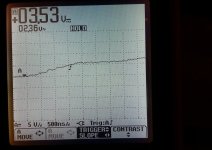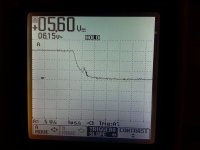zombiess
10 MW
I see this posted quite frequently but my personal experience so far has not shown any real difference in real world use (when both are built properly). In what I have read, the number one reason I have seen is the fact that the IRFB4110 FETs have a lower RDSon vs the IRFB4115. This is an absolute fact and there is no disputing it but I feel it’s important to discuss the other characteristics of the FETs to get a better picture.
I'm not mentioning operating voltage in this discussion because I'm trying to make a 1:1 comparison. When comparing them I would not exceed 100V on either FET.
Let me first post my own justification for choosing the IRFB4115 FETs in the controllers I personally build and use. Hopefully my thinking is not flawed.
1. Both of these FETs are TO-220 package which limits maximum current to around 75A which is where I choose to limit my phase amps for reliability. Because a 12 FET has two FETs in parallel I limit it to 150A phase max, 24 FET (four FETs in parallel) 300A max, etc.
2. Both will suffer similar switching losses regardless of RDSon
Volts * Switching Freq / 2 * (Turn On Time + Turn Off Time) * Phase Amps
3. RDSon makes up just a small part of overall losses, switching and diode losses are usually higher in most operating modes with diode losses especially high below 50% duty cycle.
4. The Xie Chang controllers have weak gate drivers and the IRFB4115’s are easier to drive into over saturation. IRFB4115 has a Qg of 77nC vs the IRFB4110’s QG of 150nC.
Most people on this site have seen people complaining of FET failures on controllers, sometimes it’s a single high or low side FET that that blows, other times multiple FETs in the high or low side. Reading back through several posts and info on controllers which use IRFB4115’s it is often recommended to run much lower amperage than the same controller using IRFB4110’s. I have a theory as to why it seems the IRFB4115 controllers often don’t handle similar currents as their IRFB4110 counterparts. I believe it is caused by not properly Miller Plateau matching the FETs which are paralleled together and secondarily not having enough low ESR bypass capacitance across the rails by each phase.
I arrived at the paralleling theory by individually measuring 300 IRFB4110 and 300 IRFB4115 FETs. Out of each king at least 250 of each kind were from the same batch with others coming from various other batches. The matching was done by holding the gate voltage below the miller plateau and calculating the resistance between drain and source. I noticed that the majority of the IRFB4110 FETs were pretty close to each other when all held to the same Vgs. There were some outliers that exhibited a resistance up to 100x higher than the median value, but the occurrence of these was infrequent with only around 20 out of the 300 being 50-100X higher than the most common values. The IRFB4115 FETs on the other hand had a much higher diversity of values with more even distribution into each group and less low/high value outliers.
I did not make not of exact numbers but when I grouped them into piles they went something like this:
I am using ohm values to estimate what I found when holding Vgs at a constant voltage and change the FETs.
IRFB4110 FETs
10 - 10 ohms
10 – 20 ohms
30 – 30 ohms
30 – 40 ohms
50 – 50 ohms
50 – 60 ohms
50 – 70 ohms
20 – 80 ohms
10 – 90 ohms
10 – 100 ohms
10 – 100 to 200 ohms
20 – 210 to 5000 ohms
IRFB4115 FETs
05 – 20 ohms
05 - 30 ohms
10 – 40 ohms
10 – 50 ohms
10 – 60 ohms
10 – 70 ohms
10 – 80 ohms
10 – 90 ohms
10 – 100 ohms
10 – 110 ohms
10 - 120 ohms
20 – 130 ohms
20 – 140 ohms
20 – 150 ohms
20 – 160 ohms
20 – 170 ohms
10 – 180 ohms
10 – 190 ohms
10 – 200 ohms
20 – 210 to 300 ohms
20 – 310 to 500 ohms
10 – 510 to 1500 ohms
While these numbers are not exact, they illustrate why matching paralleled FETs is important on the IRFB4115’s. If you are paralleling 4 FETs and select them at random your chances of getting FETs which are not close in conductance is pretty high which results in unequal turn on and one or two FETs having to take the full current before the other FETs turn on and share the load. The chances of getting closely matched IRFB4110’s are much better which is one reason why I believe they suffer less failures at higher currents.
I only know of myself matching FETs for use in my personal ebike controllers so my sample size is miniscule, but I have had good success with the IRFB4115’s.
I just completed a 24 FET IRFB4115 controller with a temp sensor on a switched FET bank and will build another using IRFB4110 FET with a temp sensor so I can hopefully make some comparisons in operating temp. I’d also like to measure the turn on times between them to see if one switches on/off faster than the other due to the difference in their gate charges.
I'm not mentioning operating voltage in this discussion because I'm trying to make a 1:1 comparison. When comparing them I would not exceed 100V on either FET.
Let me first post my own justification for choosing the IRFB4115 FETs in the controllers I personally build and use. Hopefully my thinking is not flawed.
1. Both of these FETs are TO-220 package which limits maximum current to around 75A which is where I choose to limit my phase amps for reliability. Because a 12 FET has two FETs in parallel I limit it to 150A phase max, 24 FET (four FETs in parallel) 300A max, etc.
2. Both will suffer similar switching losses regardless of RDSon
Volts * Switching Freq / 2 * (Turn On Time + Turn Off Time) * Phase Amps
3. RDSon makes up just a small part of overall losses, switching and diode losses are usually higher in most operating modes with diode losses especially high below 50% duty cycle.
4. The Xie Chang controllers have weak gate drivers and the IRFB4115’s are easier to drive into over saturation. IRFB4115 has a Qg of 77nC vs the IRFB4110’s QG of 150nC.
Most people on this site have seen people complaining of FET failures on controllers, sometimes it’s a single high or low side FET that that blows, other times multiple FETs in the high or low side. Reading back through several posts and info on controllers which use IRFB4115’s it is often recommended to run much lower amperage than the same controller using IRFB4110’s. I have a theory as to why it seems the IRFB4115 controllers often don’t handle similar currents as their IRFB4110 counterparts. I believe it is caused by not properly Miller Plateau matching the FETs which are paralleled together and secondarily not having enough low ESR bypass capacitance across the rails by each phase.
I arrived at the paralleling theory by individually measuring 300 IRFB4110 and 300 IRFB4115 FETs. Out of each king at least 250 of each kind were from the same batch with others coming from various other batches. The matching was done by holding the gate voltage below the miller plateau and calculating the resistance between drain and source. I noticed that the majority of the IRFB4110 FETs were pretty close to each other when all held to the same Vgs. There were some outliers that exhibited a resistance up to 100x higher than the median value, but the occurrence of these was infrequent with only around 20 out of the 300 being 50-100X higher than the most common values. The IRFB4115 FETs on the other hand had a much higher diversity of values with more even distribution into each group and less low/high value outliers.
I did not make not of exact numbers but when I grouped them into piles they went something like this:
I am using ohm values to estimate what I found when holding Vgs at a constant voltage and change the FETs.
IRFB4110 FETs
10 - 10 ohms
10 – 20 ohms
30 – 30 ohms
30 – 40 ohms
50 – 50 ohms
50 – 60 ohms
50 – 70 ohms
20 – 80 ohms
10 – 90 ohms
10 – 100 ohms
10 – 100 to 200 ohms
20 – 210 to 5000 ohms
IRFB4115 FETs
05 – 20 ohms
05 - 30 ohms
10 – 40 ohms
10 – 50 ohms
10 – 60 ohms
10 – 70 ohms
10 – 80 ohms
10 – 90 ohms
10 – 100 ohms
10 – 110 ohms
10 - 120 ohms
20 – 130 ohms
20 – 140 ohms
20 – 150 ohms
20 – 160 ohms
20 – 170 ohms
10 – 180 ohms
10 – 190 ohms
10 – 200 ohms
20 – 210 to 300 ohms
20 – 310 to 500 ohms
10 – 510 to 1500 ohms
While these numbers are not exact, they illustrate why matching paralleled FETs is important on the IRFB4115’s. If you are paralleling 4 FETs and select them at random your chances of getting FETs which are not close in conductance is pretty high which results in unequal turn on and one or two FETs having to take the full current before the other FETs turn on and share the load. The chances of getting closely matched IRFB4110’s are much better which is one reason why I believe they suffer less failures at higher currents.
I only know of myself matching FETs for use in my personal ebike controllers so my sample size is miniscule, but I have had good success with the IRFB4115’s.
I just completed a 24 FET IRFB4115 controller with a temp sensor on a switched FET bank and will build another using IRFB4110 FET with a temp sensor so I can hopefully make some comparisons in operating temp. I’d also like to measure the turn on times between them to see if one switches on/off faster than the other due to the difference in their gate charges.





